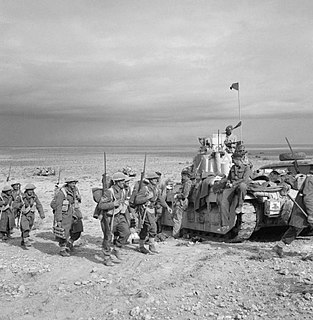The 2nd New Zealand Division, initially the New Zealand Division, was an infantry division of the New Zealand Military Forces during the Second World War. The division was commanded for most of its existence by Lieutenant-General Bernard C. Freyberg. It fought in Greece, Crete, the Western Desert and Italy. In the Western Desert Campaign, the division played a prominent role in the defeat of German and Italian forces in the Second Battle of El Alamein and the British Eighth Army's advance to Tunisia.

The military history of New Zealand during World War II began when New Zealand entered the Second World War by declaring war on Nazi Germany with Great Britain. New Zealand's forces were soon serving across Europe and beyond, where their reputation was generally very good. In particular, the force of the New Zealanders who stationed in Northern Africa and Southern Europe was known for its strength and determination, and uniquely so on both sides; German Commander of the Afrika Corps Erwin Rommel has been recorded as once saying "Give me the Māori Battalion and I will conquer the world".

The Argyll and Sutherland Highlanders was a line infantry regiment of the British Army that existed from 1881 until amalgamation into the Royal Regiment of Scotland on 28 March 2006.

Lieutenant Colonel Frederick Baker DSO was a New Zealand soldier who served in the Second World War, leading the 28th (Māori) Battalion from 13 July to 2 November 1942. He was injured at the commencement of the Second Battle of El Alamein and his wounds were such that he was repatriated back to New Zealand. He later worked in New Zealand's public service, leading the Rehabilitation Department which assisted servicemen returning from the war into civilian life, by providing them with finance, training and housing.

The 5th Indian Infantry Division was an infantry division of the Indian Army during World War II that fought in several theatres of war and was nicknamed the "Ball of Fire". It was one of the few Allied divisions to fight against three different armies - the Italian, German and Japanese armies.

The 28th (Māori) Battalion, more commonly known as the Māori Battalion, was an infantry battalion of the New Zealand Army that served during the Second World War. It formed following pressure on the Labour government from some Māori Members of Parliament (MPs) and Māori organisations throughout the country which wanted to see a full Māori unit raised for service overseas. The Māori Battalion followed in the footsteps of the Māori Pioneer Battalion that had served (1915–1919) during the First World War (1914–1918) with success. Māori wanted the formation of a distinct military unit in order to raise their profile, and to serve alongside their Pākehā compatriots as subjects of the British Empire. It also offered Māori the opportunity to prove themselves and potentially secure autonomy.

The Divisional Cavalry Regiment, was an armoured cavalry regiment of the 2nd New Zealand Division during the Second World War and was New Zealand's first armoured unit. It served as a reconnaissance force for the 2nd New Zealand Division. Formed on 29 September 1939, the regiment embarked for Egypt on 4 January 1940. It fought with the division, as part of the 2nd New Zealand Expeditionary Force, in Greece, Crete, North Africa and Italy. The regiment formed part of J Force, New Zealand's contribution to the occupation of Japan at the end of the war.
The 22nd Battalion, also known as the "Wellington Battalion", was an infantry battalion of the New Zealand Military Forces, which served during the Second World War. After undertaking defensive duties in the United Kingdom from mid-1940 until early 1941, the battalion then fought in the Battles of Greece and Crete where it suffered heavy casualties and lost a large number of men who were taken as prisoners of war. After being rebuilt, the battalion fought in North Africa, fighting in Operation Crusader, before undertaking garrison duties in Syria. It later fought in the First Battle of El Alamein during which they suffered heavy casualties at Ruweisat Ridge. Re-formed, the battalion later fought in the Second Battle of El Alamein. In late 1943, the battalion was transferred to Italy where it fought for the remainder of the war, fighting battles around Cassino and along the Adriatic coast, before entering Trieste in the final days of the war. After the war, it performed occupation duties in Japan until it was disbanded in 1948.

The 2/2nd Machine Gun Battalion was an infantry support unit of the all-volunteer Second Australian Imperial Force that was raised for service overseas during the Second World War. Formed in mid-1940 in Sydney, from personnel drawn from the states of Queensland and New South Wales, the battalion was allocated to the Australian 9th Division. After completing training in Australia, the battalion operated in the Middle East between early 1941 and early 1943, seeing action against German and Italian forces at the First and Second Battles of El Alamein, and undertaking garrison duties in Syria as part of the Allied garrison that was established there after the Syria–Lebanon campaign.

The 2/15th Battalion was an infantry battalion of the Australian Army that served during World War II. Formed in May 1940 primarily from Queensland volunteers, the battalion saw action in North Africa in 1941–1942 as part of the 20th Brigade, which was part of the 7th Division before being reassigned to the 9th Division.
The 21st Battalion was an infantry battalion of the New Zealand Military Forces that served during the Second World War. Formed in January 1940, it was part of the 5th Brigade, 2nd New Zealand Division of the 2nd New Zealand Expeditionary Force. The battalion saw action in Greece, Crete, North Africa and Italy before it was disbanded in December 1945.

The 2/24th Battalion was an infantry battalion of the Australian Army, which served during World War II. A unit of the all-volunteer Second Australian Imperial Force, it was formed in July 1940 from primarily Victorian volunteers and was known as "Wangaratta's Own" because of the time the battalion spent in the town during its formative period prior to deployment overseas. It served in North Africa in 1941–1942 as part of the 26th Brigade, which was assigned to the 7th Division, before being reassigned to the 9th Division. In early 1943, the battalion returned to Australia and later took part in campaigns against the Japanese in New Guinea in 1943–1944 and Borneo in 1945, before being disbanded in 1946. The 2/24th suffered the highest number of battle casualties of any 2nd AIF infantry battalion.

The 20th Battalion was a formation of the New Zealand Military Forces which served, initially as an infantry battalion and then as an armoured regiment, during the Second World War as part of the 2nd New Zealand Division.
The Official History of New Zealand in the Second World War 1939–45 is a 48-volume series published by the War History Branch of the Department of Internal Affairs which covered New Zealand involvement in the Second World War. The series was published during the period 1949 to 1986. A collection of booklets entitled Episodes and Studies were also published between 1948 and 1954. The Official History of New Zealand in the Second World War 1939–45 was the largest publication project undertaken in New Zealand.

Lieutenant Colonel Joseph Norris Peart was a New Zealand army officer and the fourth headmaster of King's College. He served in the army during World War II and was killed at El Alamein during the Battle of Alam el Halfa at the age of 42.

The 19th Battalion was a formation of the New Zealand Military Forces which served, initially as an infantry battalion and then as an armoured regiment, during the Second World War as part of the 2nd New Zealand Division.

The 18th Battalion was a formation of the New Zealand Military Forces which served, initially as an infantry battalion and then as an armoured regiment, during the Second World War as part of the 2nd New Zealand Division.

The 25th Battalion was an infantry battalion of the New Zealand Military Forces, which served during the Second World War as part of the 6th Infantry Brigade, 2nd New Zealand Division.
The 26th Battalion was an infantry battalion of the New Zealand Military Forces, which served during the Second World War as part of the New Zealand 2nd Division. Raised in May 1940, it fought in the Battle of Greece, the North African Campaign and the Italian Campaign. It finished the war in Trieste and was disbanded in December 1945.
The 9th Brigade was a formation of the New Zealand Military Forces raised for service in Italy during the Second World War. As part of the 2nd New Zealand Division, it participated in Operation Grapeshot in 1945. It then provided the basis of J Force, the New Zealand contribution to the British Commonwealth Occupation Force.













